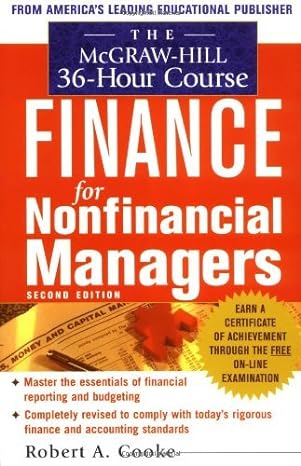Question
Toowoomba Jewellery, a distributor of earring to various retail outlets located in shopping malls across the country. In the past, the company has done very
Toowoomba Jewellery, a distributor of earring to various retail outlets located in shopping malls across the country. In the past, the company has done very little in the way of budgeting and at certain times of the year has experienced a shortage of cash. Since you are well trained in budgeting, you have decided to prepare a master budget for the upcoming second quarter. To this end, you have worked with accounting and other areas to gather the information assembled below. The company sells many styles of earring, but all are sold for the same price$10 per pair. Actual sales of earrings for the last three months and budgeted sales for the next six months follow: January (actual) 20,000 February (actual) 26,000 March (actual) 40,000 April (budget) 65,000 May (budget) 100,000 June (budget) 50,000 July (budget) 30,000 August (budget) 28,000 September (budget) 25,000 The concentration of sales before and during May is due to Mother's Day. Sufficient inventory should be on hand at the end of each month to supply 40% of the earrings sold in the following month. Suppliers are paid $4 for a pair of earrings. One-half of a month's purchases is paid for in the month of purchase; the other half is paid for in the following month. All sales are on credit. Only 20% of a month's sales are collected in the month of sale. An additional 70% is collected in the following month, and the remaining 10% is collected in the second month following sale. Bad debts have been negligible. 5 Monthly operating expenses for the company are given below: Variable 4% of sales Fixed Advertising $2,00,000 Rent 18,000 Salaries 106,000 Utilities 7,000 Insurance 3,000 Depreciation 14,000 Insurance is paid on an annual basis, in November of each year. The company plans to purchase $16,000 in new equipment during May and S40,000 in new equipment during June; both purchases will be for cash. The company declares dividends of $15,000 each quarter, payable in the first month of the following quarter. The company's balance sheet as of March 31 is given below: Assets Cash 74,000 Accounts receivable ($26,000 February sales, $320,000 March sales) 346,000 Inventory 104,000 Prepaid insurance 21,000 Property and equipment 950,000 Total assets 1,495,000 Liabilities and equities Accounts payable 100,000 Dividends payable 15,000 Common shares 800,000 Retained earnings 580,000 Total liabilities and equities 1,495,000 The company maintains a minimum cash balance of $50,000. All borrowing is done at the beginning of a month; any repayments are made at the end of a month. 6 The company has an agreement with a bank that allows the company to borrow in increments of $ 1,000 at the beginning of each month. The interest rate of these loans is 1% per month and for simplicity we will assume that interest is not compounded. At the end of the quarter, the company would pay the bank all the accumulated interest on the loan and as much of the loan as possible (in increments of $1,000), while still retaining at least $50,000 in cash.
ANSWER PROVIDED BY EXPERT BELOW PREVIOUSLY:
As the minimum cash balance required is $50,000, the company does not need to borrow any money.
Budgeted Income Statement using the Contribution Approach:
Revenue: Sales revenue: $2,150,000
Cost of goods sold:
Beginning inventory: $104,000
Add: Merchandise purchases: $344,000
Total cost of goods available for sale: $448,000
Less: Ending inventory: $68,400 I am not sure how this figure has been calculated? Can you please explain?
Cost of goods sold: $379,600
Gross profit: $1,770,400
Operating expenses:
Variable expenses: $86,016 (4% of sales) I am not sure if I am wrong here, however shouldn't this figure be $2,150,000 x 4% = $86,000?
Fixed expenses: $344,000 Is this correct? $200,000 + $18,000 + $106,000 + $7,000 + $3,000 + $14,000 = $348,000?
Total operating expenses: $430,016 Therefore if I am correct above, this figure should be $434,000
Net income before taxes: $1,340,384 Therefore making this figure $1,336,400
Budgeted Balance Sheet as of June 30: Assets:
Cash: $103,000
Accounts receivable: $302,000 How was this figure calculated?
Inventory: $68,400
Prepaid insurance: $21,000
Property and equipment: $1,006,000
Total assets: $1,500,400
Liabilities and equity:
Accounts payable: $86,000 How as this figure calculated?
Dividends payable: $15,000
Common shares: $800,000
Retained earnings: $599,400
Total liabilities and equity: $1,500,400
ANSWER PROVIDED BY EXPERT ABOVE PREVIOUSLY: i HAVE ADDED multiple questions in bold to clarify as I am not sure if I have calculated the figures incorrectly while learning this myself? Can you please confirm all of these so I can understand?
Below is the response from the expert to my question and using this calculation for the ending inventory I do not get $68,400 so need to understand what I have done wrong or if the expert has provided me with the wrong answer.
First, let's address the calculation for ending inventory on the budgeted income statement. To calculate the ending inventory, you need to multiply the budgeted sales for the following month by the percentage of those sales that should be supplied by the current month's ending inventory. In this case, the budgeted sales for May are $100,000, and 40% of those sales should be supplied by the current month's ending inventory. Therefore, the ending inventory for April should be $40,000 (=$100,000 x 40%).
Step by Step Solution
There are 3 Steps involved in it
Step: 1

Get Instant Access to Expert-Tailored Solutions
See step-by-step solutions with expert insights and AI powered tools for academic success
Step: 2

Step: 3

Ace Your Homework with AI
Get the answers you need in no time with our AI-driven, step-by-step assistance
Get Started


